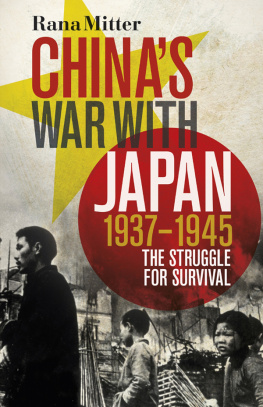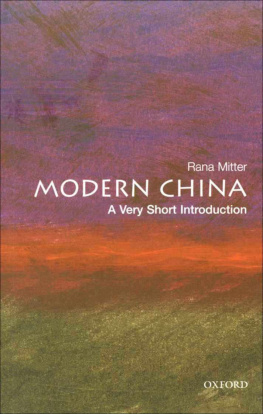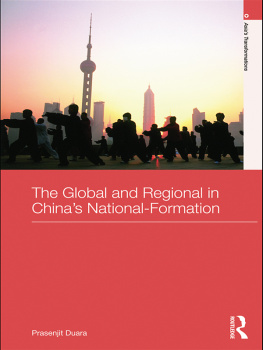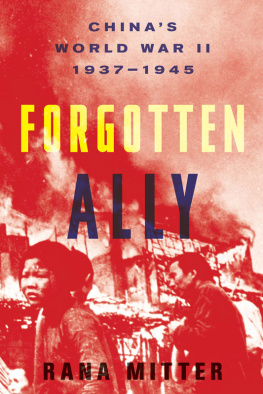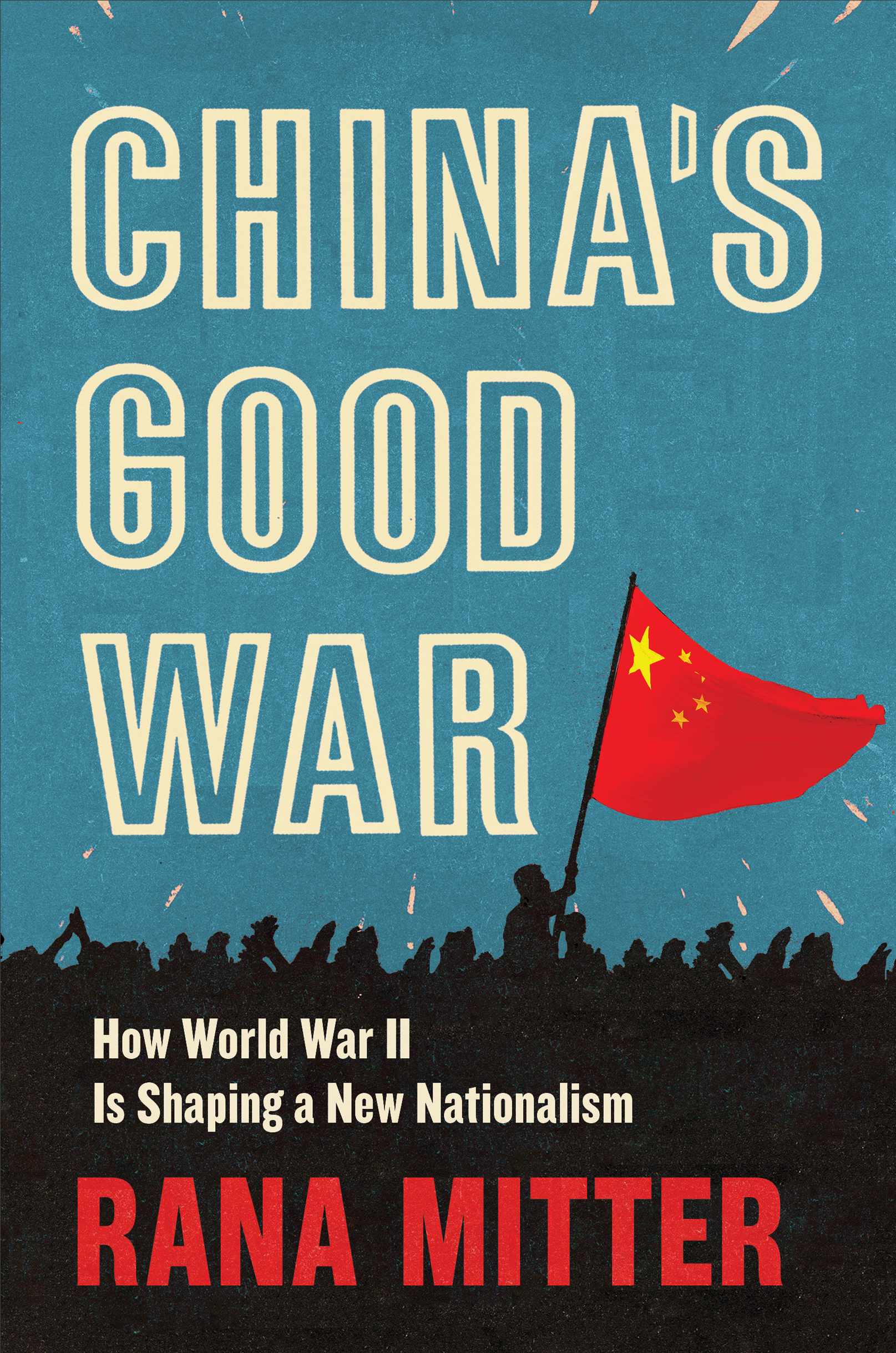Contents
Guide
Pagebreaks of the print version
CHINAS GOOD WAR
How World War II
Is Shaping a
New Nationalism
Rana Mitter
THE BELKNAP PRESS OF HARVARD UNIVERSITY PRESS
Cambridge, Massachusetts
London, England
2020
Copyright 2020 by Rana Mitter
All rights reserved
Jacket design: Jaya Miceli
Jacket illustration based on photo by Guang Niu/Getty Images
978-0-674-98426-4 (cloth)
978-0-674-24955-4 (EPUB)
978-0-674-24956-1 (MOBI)
978-0-674-24957-8 (PDF)
The Library of Congress has cataloged the printed edition as follows:
Names: Mitter, Rana, 1969 author.
Title: Chinas good war : how World War II is shaping a new nationalism / Rana Mitter.
Description: Cambridge, Massachusetts : The Belknap Press of Harvard University Press, 2020. | Includes bibliographical references and index.
Identifiers: LCCN 2020005100
Subjects: LCSH: Nationalism and collective memoryChina. | Sino-Japanese War, 19371945Public opinion. | ChineseAttitudes. | ChinaHistoriography. | ChinaCivilization1949
Classification: LCC DS777.6 .M58 2020 | DDC 320.540951dc23
LC record available at https://lccn.loc.gov/2020005100
For Malavika and Iskandar
Ce sont les morts qui se relvent
Ce sont les soldats morts qui rvent
Aux amours qui sen sont alls
Immaculs
Et dsols
Guillaume Apollinaire, Les Attentives
Contents
Some eight decades after its conclusion, the Second World War still grips the imagination of large parts of North America, Europe, and Asia. Tom Brokaws book The Greatest Generation (1998) and Steven Spielberg and Tom Hankss miniseries Band of Brothers (2001) captivated American readers and viewers and remain cultural touchstones. British politicians use metaphors about Dunkirk and the Battle of Britain to describe the countrys decision to exit from the European Union, and the sitcom Dads Army, gently teasing the wartime Home Guard, still plays on television half a century after it was made. Japanese filmmakers produce movies that explore topics from home-front suffering to the mentality of kamikaze pilots. Courts in Poland adjudicate the legally correct description of death camps built during the Nazi occupation. The Second World War is a long way from being all that these societies think about, of course. But in the United States, Europe east and west, and Japan, there is a continuing undercurrent of collective memory about the importance of the global conflict that does not take too much effort to bring to the surface.
Perhaps more surprisingly, the same is true of China. When outsiders think of collective memory in China, they tend to remember particular historical moments, many of them traumaticthe Cultural Revolution, or the Opium Wars of the nineteenth century. Or, more positively, the legacy of traditional Chinese thought may come to mind. In the past few decades, however, memories of another episode have become ever more prominent in China: the Second World War. Schoolchildren file by the thousands through the Beijing museum that commemorates the War of Resistance against Japan, as the conflict is known in China. Movies about topics from the massacre of Chinese civilians in Japanese-occupied Nanjing to starvation in a wartime famine in Henan top the Chinese box office. Online, netizens debate the finer points of the Battle of Shanghai in 1937, assessing the relative strength of the Chinese and Japanese troops that lined up against one another by the banks of the Huangpu River.
One particular moment in 2015 captured the way the war has entered the Chinese public sphere, with reminders of the past used to make points about the future. On 3 September 2015, Tiananmen Square, at the heart of Beijing, was filled by an enormous parade. Missiles, tanks, and marching soldiers all made their way past thousands of spectators from China and abroad. The event commemorated the seventieth anniversary of the end of World War II in Asia. It stood in stark contrast to the elegiac tone of many of the memorials in Europe the preceding spring. On the anniversary of the liberation of Auschwitz in January 1945, as on VE Day the following May, there was a strong sense that the end of a narrative had been reachedveterans and survivors attending a seventieth anniversary in the knowledge that few of them would be there for the eightieth. In China, while veterans stood at the center of the parade, there was a much stronger sense that the military display was part of a definition of a new China rather than a farewell to the old one.
The Chinese event was distinctive in another important way. The parade was the first national, large-scale public commemoration of Chinas role in the Second World War. It was a major milestone in a process that had been taking place over a long period of timesome thirty years or moreduring which Chinas attitude toward collective memory of its wartime participation changed significantly, with profound consequences for its domestic and international politics.
I was present in Beijing for the parade. Having spent around twenty years observing and writing about the changing relationship China has with its own wartime history, I found it a fascinating event that confirmed ideas I had been thinking about for some time. While researching a book I published in 2013 on the history of Chinas World War II experience (titled Forgotten Ally in North America, and Chinas War with Japan, 19371945 elsewhere), I had become increasingly convinced that the war was very far from being long-past history; instead, it remained alive in every aspect of Chinese life, from museums to movies to new media. The generous offer to deliver the Wiles Lectures at Queens University Belfast in 2014 gave me an opportunity to reflect on why the 1930s and 1940s have erupted back into the political and cultural life of China in the past four decades. I was also able to think about how media portrayed the conflict when I presented a television documentary on the topic titled WWII: Chinas Forgotten War.
This book, which emerged from those reflections and experiences, argues that there is a strong relationship between Chinas memory of its experience of World War II and its present-day nationalist identity at home and global role abroad. In territorial disputes and in designing patriotic education, China refers back, again and again, to the war. Contemporary China is shaped by an assertive internationalism in the region and globally, and by an equally assertive nationalism in its domestic politics. Both of these elements are profoundly, if not always obviously, shaped by Chinas changing understanding of its own history during the Second World War.
Chinas engagement with other countries has become deeply shaped by ideas about the Second World Warboth by the events and purpose of the war, and by its legacy. This is a major shift from how it previously presented itself. During the Cold War, Chinas primary national narrative came from its self-definition as a communist, revolutionary, anti-imperialist state. In the twenty-first century, much of Chinas standing and sense of itself has come from its extraordinary economic success. However, this story of growing wealth has little morally weighted content. In part, it has been tarnished by Chinas lack of compliance with developing norms of international behavior, for instance on human rights, although the country has sought to develop moral ballast elsewhere by entering the World Trade Organization (WTO) and by addressing climate change. China is currently both assertive, as demonstrated by its territorial claims in the East and South China Seas, and internationalist, as shown by its desire both to shape existing international institutions and to create new ones of its own, such as the Asian Infrastructure Investment Bank (established in 2015). Yet it is keen for its growing presence in the world to be seen as one of normative and moral leadership, rather than leadership defined solely by economic and military weight. One sign of this has been the almost obsessive concern with developing what Joseph S. Nye Jr. has called soft power.



